Word-of-mouth marketing can boost your marketing like nothing else. It has been said that it has a conversion rate of four times higher than other acquisition channels, such as paid traffic. This premise sounded so exciting that you’ve applied a referral program to your business. Hooray!
But after months or even years of toil, why in the world are you not getting the customers you expect?
There’s one sure answer for that, and that is because the referrals are not resonating with what you are offering. But you know, leads can easily be turned into actual paying customers if you know how to “speak” to them properly.
And how do you speak their language? Easy—learn about who they are first! When you are able to identify your target market and segment them properly, you’ll be able to create follow-up marketing tactics that can make it hard for them to resist.
Ready to increase your conversion rate from referral to clients? Keep reading!
Significance of Target Market and Segmentation in Referral Marketing
What is a Target Market?
Target Market is the specific group of customers that businesses aim to attract and retain. By knowing who your target audience is, you can customize your message and incentives to match their interests, needs, and behaviors.
This increases the chances of them actually making a purchase or taking action on your referral program. In referral marketing, identifying your target market is necessary because it helps you focus your efforts on the right people.
The truth is if you don’t know who your target audience is, you can expect your business to flop. When you created your business or tool, I’m pretty sure you already have an audience in mind. All it takes now is going about it the scientific way (or a data-driven way) to understand them better.
What is Customer Segmentation?
Segmentation takes things one step further by dividing your target market into smaller groups. It’s like sorting through a mix-and-match sock drawer—except instead of socks, you’ve got a diverse customer base, each with unique quirks and preferences.
The goal? To organize this eclectic bunch into smaller, more manageable groups that share similar characteristics, behaviors, or needs. When you speak to these segments differently in your referral marketing efforts, they will respond better.
Customer Segmentation is not just nice to have; it’s a must-have!
Why Segmentation Matters in Referral Marketing
Segmentation allows businesses to divide their customer base into distinct groups based on specific characteristics. Here’s how that can help:
- Effective Targeting: Like a seasoned navigator charting a precise course, you know exactly where to direct your marketing efforts. This savvy targeting ensures that your message lands perfectly with your audience, so you can find treasure on the first dig.
- Optimized Resource Allocation: Now, as a smart traveler packing for a grand adventure, instead of stuffing your suitcase haphazardly, you carefully select only what you need. When you segment your audience, you use resources efficiently. Every dollar spent has a purpose.
- Enhanced Customer Engagement: Segmentation also allows businesses to create meaningful connections with their customers, resulting in higher engagement. This will help them build stronger relationships with their audience.
- Higher Conversion Rates: With precise segmentation, you can guide your referrals to perfectly planned routes, a.k.a. marketing funnels, that resonate with them. And because they can relate to these funnels better, you can expect better conversion rates.
- Increased Customer Loyalty: Building customer loyalty is akin to a gardener nurturing a prized rosebush. With tailored communication, you’re watering the relationships with existing customers, helping them bloom with loyalty and ensuring they thrive season after season. This means increased customer lifetime value.
- Strong Brand Messaging: Segmenting your customer base allows you to refine and sharpen your brand messaging to better resonate with each segment. By speaking their language, you can nurture a stronger connection with your audience and build a more recognizable and impactful brand.
- Growth Opportunities: Let’s admit it—sometimes, the most profitable customers come from segments that we did not initially consider. With segmentation, you can uncover growth opportunities and tap into new markets that were previously untapped. This allows businesses to expand their reach and drive sustained growth.
- Identifying High-Value Referrers and Advocates: Segmenting your target customers also helps identify who among your referrers delivers the best value. These are the loyal customers who not only make referrals but also deliver those that convert into actual customers. You can, therefore, increase your efforts and budgets toward such segments for better Return on Investment (ROI).
In essence, customer segmentation isn’t just about categorizing your audience—it’s about unlocking the potential for meaningful interactions and driving business growth through informed, strategic referrals.
The Different Types of Market Segments
Now, let’s get down to business. There’s more to segmentation than separating people based on age and location (although that is a part of it). There are several of these types, under them, even further more! We promise to make it easy to understand in our explanation below.
Demographic Segmentation
Demography is all about the statistical study of populations, focusing on aspects like size, density, distribution, and vital stats such as birth and death rates.
When it comes to marketing, demographic segmentation means breaking down your audience into distinct groups based on measurable traits like age, gender, income, education, occupation, and sometimes even family size.
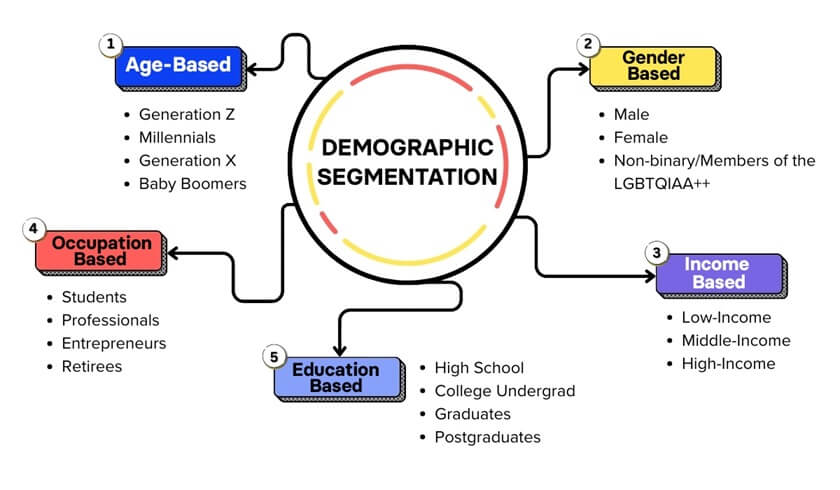
Age-Based Segmentation
Age is more than just a number; it’s a window into different life stages and priorities.
Think about how a referral campaign might appeal to a tech-savvy Gen Z audience versus a more traditional Baby Boomer crowd. For instance, a trendy new app might offer Gen Z users incentives to share it on social media, while Boomers might appreciate a referral email with detailed benefits.
Tailoring your approach based on age ensures your message feels relevant and engaging. Here’s a run-down of how you can do that:
Age-Based Segmentation in Referral Marketing
- Generation Z (born 1997-2012)
- Characteristics: Digital natives, social media enthusiasts, values authenticity.
- Preferences: Interactive content, instant gratification, mobile-first experiences.
- Referral Strategies: Leverage social media platforms for viral campaigns, make full use of viral marketing, and use influencers they trust.
- Millennials (born 1981-1996)
- Characteristics: Tech-savvy, values experiences over possessions, socially conscious.
- Preferences: Personalized experiences, eco-friendly products, digital engagement.
- Referral Strategies: Create referral programs with experiential rewards, offer gamified referral programs, utilize social proof and reviews, and highlight sustainability initiatives.
- Generation X (born 1965-1980)
- Characteristics: Independent, values convenience, brand-loyal.
- Preferences: Email and digital content, loyalty programs, work-life balance.
- Referral Strategies: Offer referral discounts on practical products or services, use email campaigns for referrals, and incorporate loyalty rewards.
- Baby Boomers (born 1946-1964)
- Characteristics: Traditional media consumers, values consistency, brand loyal.
- Preferences: Quality and value, face-to-face interactions, simple tech solutions.
- Referral Strategies: Implement referral programs with straightforward incentives, utilize email and direct mail for communication, and emphasize product reliability.
- Seniors (born before 1946)
- Characteristics: Trust established brands, leisurely pace, cautious spenders.
- Preferences: Direct communication, in-person services, reliability.
- Referral Strategies: Use clear and simple referral processes, provide tangible rewards or discounts, and focus on community-based referrals.
Gender-Based Segmentation
Gender-based segmentation lets you hone in on interests and preferences that often (though not exclusively) align with gender.
A fitness brand, for example, might create separate referral campaigns highlighting women’s yoga gear and men’s weightlifting equipment. Addressing these specific interests can make your referral message feel personal and tailored, increasing the chances recipients will pass it along to their peers.
Gender-Based Segmentation in Referral Marketing
Side Note: These below are just generalized overviews, but there are different characteristics to each market segment that you need to dive deeper to target your audiences better. What we have below is purely for example purposes and may not always fit.
- Male
- Characteristics: Values practicality, often brand-loyal, focused on performance and efficiency.
- Preferences: Tech gadgets, sports, automotive products, and grooming.
- Referral Strategies: Highlight performance benefits in referral campaigns, use influencer partnerships in technology and sports, and offer loyalty rewards for referrals in tech and automotive sectors.
- Female
- Characteristics: Values quality and aesthetics, brand-conscious, socially connected.
- Preferences: Fashion, beauty, wellness, and home decor.
- Referral Strategies: Emphasize aesthetics and quality in referral messaging, create community-driven campaigns, collaborate with beauty and lifestyle influencers, and offer exclusive access to new collections or products.
- Non-binary/Members of LGBTQIAA++
- Characteristics: Seek inclusivity and representation, values authenticity and diversity.
- Preferences: Gender-neutral products, inclusive brands, and social justice-oriented initiatives.
- Referral Strategies: Develop campaigns that emphasize inclusivity and diversity, use gender-neutral language in referral programs, partner with advocates and influencers who promote diversity and inclusivity, and offer incentives that align with social causes or community support.
Income-Based Segmentation
Income can dictate not just purchasing power, but also spending habits and priorities. For luxury brands, targeting higher-income segments with exclusive referral rewards can enhance the allure of exclusivity.
On the other side of the coin, brands offering budget-friendly products might focus on value-driven referral incentives, ensuring they speak the right language to economically-conscious consumers.
Income-Based Segmentation in Referral Marketing
- Low Income
- Characteristics: Budget-conscious, values deals and discounts, prioritizes necessities.
- Preferences: Affordable products, clear value propositions, and practical solutions.
- Referral Strategies: Offer referral discounts or cashback deals, create programs that emphasize cost-savings, and highlight product durability and value in messaging. Think of it as a chance to show them how they can save a buck or two while still enjoying quality.
- Middle Income
- Characteristics: Balance quality and affordability, values experiences and convenience.
- Preferences: Reliable brands, products that enhance lifestyle, and efficient services.
- Referral Strategies: Provide referral incentives that offer experiential rewards, such as travel discounts or entertainment vouchers. Craft campaigns that showcase how your product or service makes life easier without breaking the bank.
- High Income
- Characteristics: Luxury seekers, status-driven, appreciates exclusivity.
- Preferences: Premium brands, innovative products, and personalized services.
- Referral Strategies: Highlight exclusivity and prestige in referral campaigns, offer luxury incentives like VIP access or bespoke services. It’s all about making them feel part of an elite club that knows what quality truly means.
Occupation-Based Segmentation
In the SaaS world, occupation-based segmentation is where the magic happens. People in similar jobs often face similar challenges, making them prime candidates for specific SaaS tools.
Imagine a project management software targeting marketing managers with a referral campaign that highlights features tailored to their daily tasks. This approach not only makes the referral relevant but also positions the product as a solution to their professional needs.
Of course, the audience’s occupation is important in other industries as well; SaaS is just a prime example.
Occupation-Based Segmentation in Referral Marketing
- Students
- Buzzwords: Curious, tech-savvy, always learning.
- Crave: Flexibility, student discounts, and anything that screams “cool.”
- Referral Tactics: Tap into their social networks with referral programs that offer tech gadgets, exclusive online content, or popular brand collaborations. Make it fun and interactive, like a digital treasure hunt that leads to rewards they’ll love!
- Professionals
- Buzzwords: Ambitious, time-strapped, efficiency seekers.
- Crave: Convenience, premium services, and career growth.
- Referral Tactics: Offer perks like skill-enhancing courses, VIP access to industry events, or sleek productivity tools. Make it a no-brainer for them to share—think streamlined processes and enticing incentives that align with their career goals.
- Entrepreneurs
- Buzzwords: Dynamic, risk-takers, visionaries.
- Crave: Networking, cutting-edge solutions, and a dash of exclusivity.
- Referral Tactics: Create referral campaigns that offer access to mastermind groups, business software trials, or bespoke consultancy sessions. Fuel their entrepreneurial spirit with opportunities to connect and grow their ventures.
- Retirees
- Buzzwords: Relaxed, experienced, lifestyle-focused.
- Crave: Quality experiences, community engagement, and lifelong learning.
- Referral Tactics: Engage them with referrals that unlock travel discounts, hobby classes, or wellness packages. Highlight the joy of discovery and connection, making them eager to share these enriching opportunities with their peers.
These occupation segments can be further divided. For example, professionals can be subdivided into administrative positions, managerial positions, and service professionals who don’t fall under corporate positions.
Education-Based Segmentation
Education level influences consumer preferences and purchasing decisions.
A company offering development resources might aim at graduate and post-graduate folks, focusing on advanced features and special content. Meanwhile, a brand with personal finance tools could attract more people by highlighting user-friendly designs and handy tips.
Some businesses lump together education levels with occupation-based segmentation, but we suggest separating them. A person can be an undergrad but is also an entrepreneur or someone who holds a professional position, right?
Education-Based Segmentation in Referral Marketing
- High School
- Traits: Always online, trendsetters, vibe checkers.
- Likes: Cool apps, viral content, and quick, fun interactions.
- Referral Moves: Turn them into brand ambassadors with shareable challenges and rewards. Think meme-worthy content that gets them tagging friends faster than you can say “hashtag.”
- Undergrad
- Traits: Penny-pinchers, social butterflies, brand experimenters.
- Likes: Discounts, social gatherings, and anything that screams “student deal.”
- Referral Moves: Offer exclusive student deals and create buzz with campus reps. Host online hangouts or webinars that offer both fun and a hint of future career wisdom.
- College Graduates/Degree Holder
- Traits: Career climbers, skill seekers, value-driven.
- Likes: Networking, professional gear, and opportunities to shine.
- Referral Moves: Entice them with referrals that unlock access to industry events, skill-boosting workshops, or elite networking opportunities. Let them know how your product can be their secret weapon on the career ladder.
- Postgraduates
- Traits: Intellectuals, thought leaders, efficiency aficionados.
- Likes: Deep dives, cutting-edge info, and anything that saves time.
- Referral Moves: Offer exclusive content like research insights or advanced tools that speak to their scholarly hearts. Make your campaigns a blend of intellect and innovation they can’t resist sharing.
Understanding and leveraging these demographic factors can help businesses craft referral marketing campaigns that strike a chord with their target audience. Each demographic slice offers insights that help personalize the referral experience, making it more likely to resonate and spread, just like a catchy tune that everyone wants to share.
Psychographic Segmentation
Psychographic segmentation is a key tool in a marketer’s toolkit, helping businesses get to know their customers better. This focuses on the lifestyle, interests, values, and personality traits. With it, companies can create referral marketing strategies that really connect on a personal level.
Let’s dive into these subtopics and see how they can enhance referral marketing efforts.
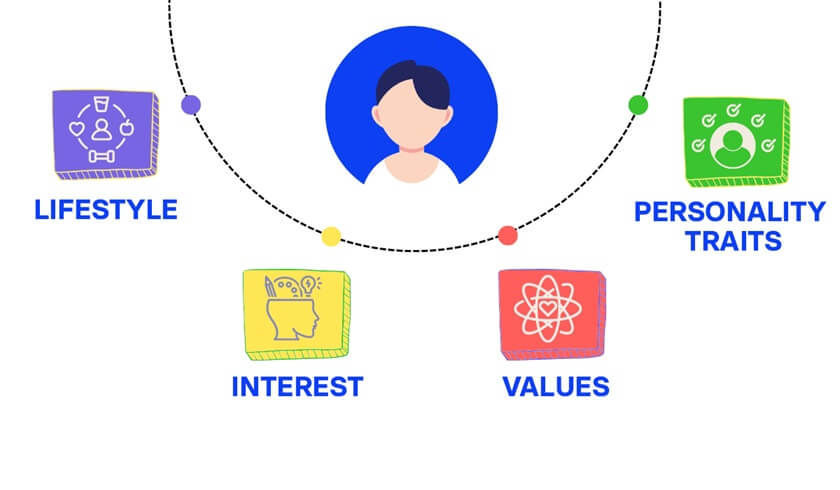
Lifestyle: Understanding Daily Routines and Preferences
Lifestyle segmentation involves examining how customers allocate their time and resources, including activities they enjoy and the types of brands they interact with. This insight is crucial for creating referral programs that seamlessly integrate into their daily routines.
Take fitness enthusiasts as an example—a referral program with gym membership discounts or fitness gear could really hook them. But if they’re the outdoors kind of people, they’d probably be more interested with travel and outdoor group tours.
Matching referral incentives with lifestyle choices boosts engagement and increases the chances of successful referrals.
Interests: Tapping into Customer Passions
Interests are those fun hobbies and activities that grab your audience’s attention. By pinpointing these passions, referral programs can offer rewards that truly excite and motivate customers to share.
One great example is the Opal App, which targets people who are techy but would like to reduce their screen time. Audiences that fall under this market are younger generations who are hip and would like to focus more on passions and enjoying life. As such, Opal launched a referral contest where the top referrer receives two tickets to Glastonbury Music Festival 2024—a music festival whose target market is, guess what, the younger generations as well!
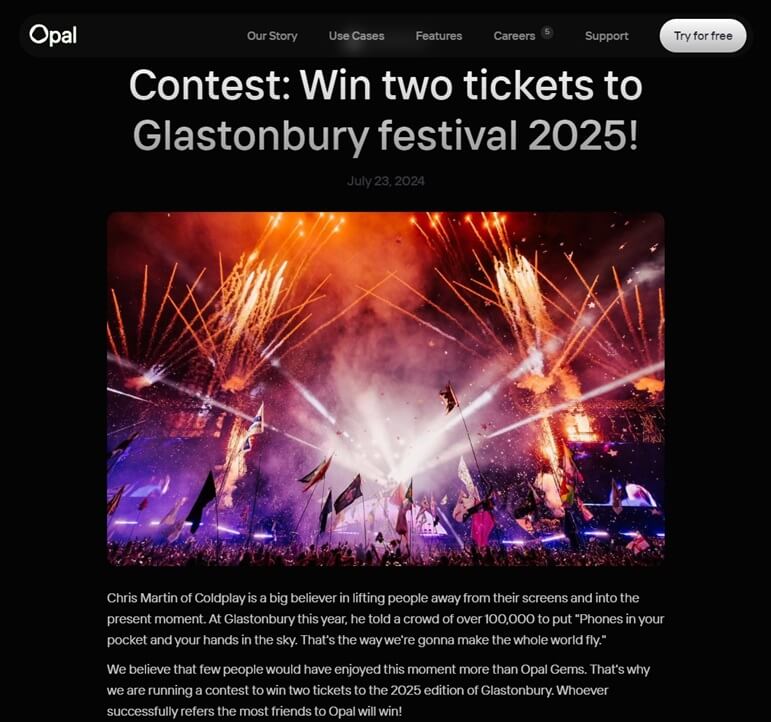
As someone who falls under this target market, I kid you not, I was encouraged to download the app and refer it to friends!
This is proof that this referral program’s style to keep in mind a user’s interest not only sparks sharing but also creates a lively community of brand advocates who are genuinely into what the company offers.
Values: Aligning with Customer Beliefs
Values are the compass that guides your customer’s choices. Using psychographic segmentation, businesses can match their referral messages to these core values. It sparks a shared sense of purpose.
For instance, a brand that prioritizes sustainability can target eco-conscious consumers by crafting referral campaigns that emphasize their environmental initiatives. Tapping into shared values, companies earn trust and create powerful emotional bonds, turning customers into passionate advocates.
Personality Traits: Crafting Personalized Experiences
Personality traits can significantly influence how customers interact with brands and share experiences. Referral marketing can leverage these traits by personalizing approaches to different personality types.
Let’s see how that can work:
- Extroverts: The Life of the (Referral) Party
These social butterflies thrive in interactive environments. For extroverts, think social media challenges or group referral campaigns. They’ll spread the word faster than you can say “viral,” turning their enthusiasm into your marketing gold. - Introverts: The Quiet Strategists
Introverts prefer the cozy corners of the internet, away from the limelight. Offer them private, exclusive referral codes or one-on-one rewards. They’ll quietly become your most loyal ambassadors, sharing with thoughtfulness and precision. - Open-Minded Explorers
These customers are always up for an adventure. Capture their curiosity with innovative, out-of-the-box referral offers. Think mystery rewards or surprise bonuses that keep them guessing—and referring—every time. - Conscientious Champions
Detail-oriented and responsible, they appreciate a referral program that’s as organized as they are. Provide clear, straightforward referral processes with transparent tracking. They’ll become your methodical marketers, ensuring every referral counts. - Agreeable Allies
These folks are all about harmony and collaboration. Create referral programs that encourage teamwork or community benefits. They’ll rally their friends, ensuring everyone wins and fostering a sense of camaraderie. - Cautious Curators
These individuals appreciate careful planning and love structure. They value security and assurance in every step. Design referral programs with clear, guaranteed outcomes or risk-free trials. Once convinced of the reliability, they’ll share your brand with a deliberate and thoughtful recommendation.
Inject a little personality into your referral marketing, and watch as your campaigns resonate with each customer’s unique traits!
Geographic Segmentation
Geographic segmentation looks at where your customers are located. Things like climate, cultural differences, and regional preferences can shape buying decisions. By customizing referral campaigns for specific areas, businesses can better meet local needs and preferences.
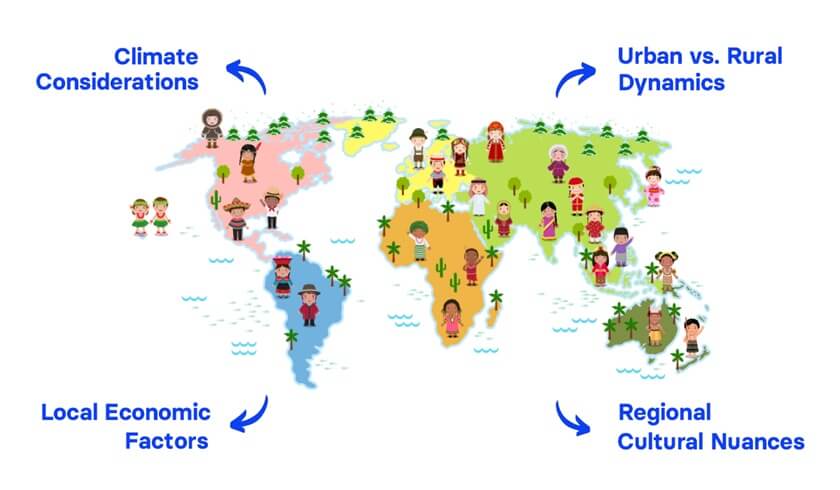
Here are the main considerations:
Climate Considerations
Climate plays a pivotal role in shaping consumer behavior and preferences. In referral marketing, aligning your strategies with climatic conditions can enhance relevance and impact.
For instance, seasonal items like winter gear or summer beach attire as referral rewards can work best during the right season, depending on the referrer or referral’s location.
Geographic Accessibility: Urban vs. Rural Dynamics
Accessibility considerations can influence the effectiveness of referral marketing. Understanding the difference between urban and rural areas is key to crafting referral strategies.
In cities, people might prefer digital referral campaigns because they use the internet and smartphones more. On the other hand, folks in rural areas might respond better to traditional methods or community-based referrals that focus on personal connections and local involvement.
Tailoring delivery options to local logistical realities can also enhance customer satisfaction and referral success.
Regional Cultural Nuances
Cultural differences across regions call for a tailored approach in referral marketing. You can create campaigns that really resonate if you understand the regional festivals, traditions, and local customs.
Launching a referral program that ties in with a big regional event can greatly enhance participation and connection. For instance, if you’re promoting to Mexican audiences and it’s April or the start of May, coincide your referral promotion with Cinco de Mayo to generate more interest.
Local Economic Factors
Economic conditions vary widely across different geographic locations. Referral marketing strategies should consider local economic factors, adjusting incentives accordingly to suit the financial realities of the target audience.
In developing countries, a discount of $5 means a lot, while in first world countries, you’d likely be met with a snob.
Offering discounts or value-based rewards might be more appealing in economically constrained areas.
Behavioral Segmentation
Behavioral segmentation examines the purchasing behavior, engagement levels, and referral patterns of customers. This approach helps in identifying high-value customers who are more likely to refer others.
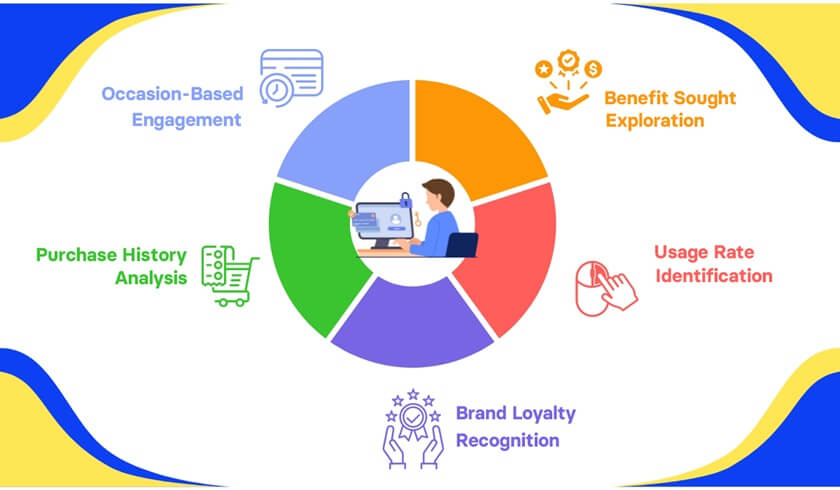
Mastering Behavioral Segmentation in Referral Marketing
Purchase History Analysis
Dive into the treasure trove of purchase history. By understanding what and when your customers buy, you can tailor referral rewards to fit their buying habits.
For example, if a customer frequently purchases athletic gear, offer them a discount on new arrivals of such items for each referral they make.
Website Interaction
Customers interact with your brand at varying frequencies—some are daily enthusiasts, others pop in now and then. Monitoring customer interactions on a website—like page views, time spent, and clicks—provides valuable info on their interests and preferences.
Identify these usage patterns to craft your referral strategy. Heavy users might appreciate exclusive previews or early access rewards, while occasional users could be enticed with reminders of perks they might miss.
Brand Loyalty Recognition
Loyal customers are your brand’s cheerleaders. Recognize and reward their unwavering support by creating a loyalty-based referral program. Offer tiered rewards that grow as they refer more friends, or create a VIP club for top referrers with exclusive benefits.
Benefit Sought Exploration
Different strokes for different folks—customers look for varied benefits like quality, price, or convenience. Tailor referral incentives based on these preferences. For instance, for those seeking value, offer direct discounts, while quality-seekers might appreciate a premium upgrade for every referral.
Occasion-Based Engagement
Tap into the occasions that matter to your customers. Whether it’s birthdays, anniversaries, or holidays, create targeted referral campaigns that celebrate these moments. Send personalized messages with special offers when they refer friends during these occasions.
When you weave behavioral segmentation into your referral marketing, you not only understand your customers better but also engage them in ways that resonate personally. It’s about blending expertise with a personal touch, ensuring your strategies aren’t just effective—they’re memorable.
How to Apply Target Market Segmentation for Referral Programs
We’ve already added some insights above on how you can incorporate target market and segmentation into your referral marketing tactics, but let’s take it a step further and discuss concrete steps.
Here’s how you can develop custom segments tailored to your business needs and customer insights to make sure your referral strategies hit the mark.
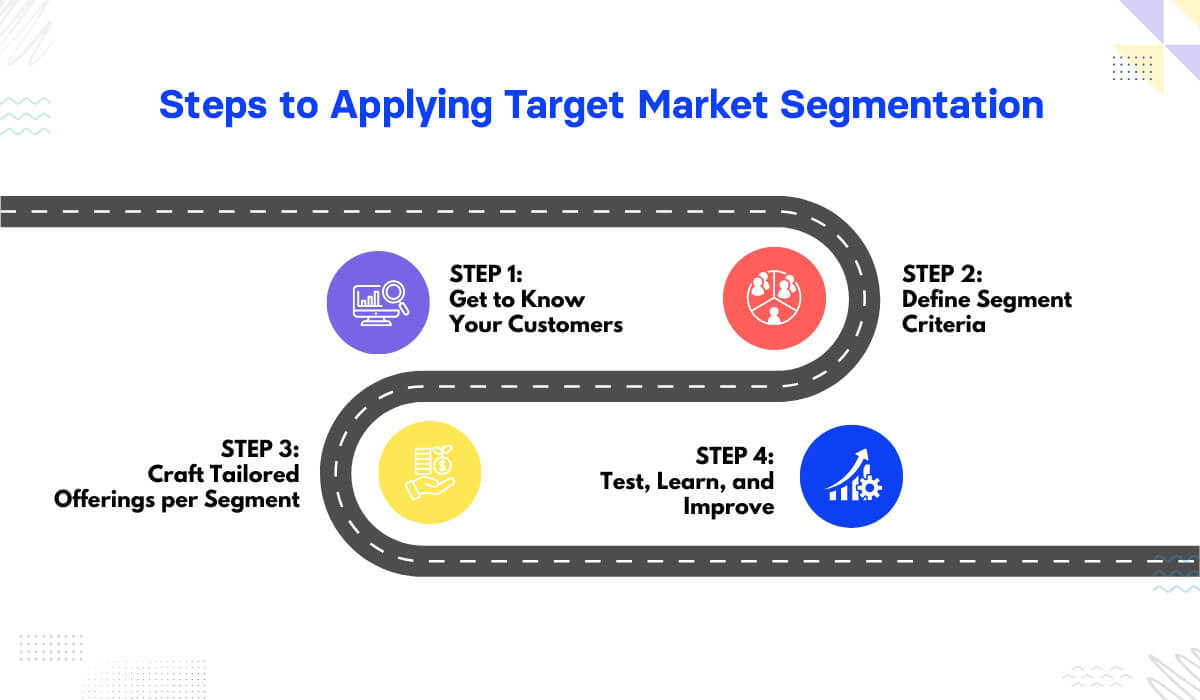
Step 1: Get to Know Your Customers
Start with Some Detective Work
Gather information from places like customer surveys, online behavior, purchase history, and social media. Think of it as gathering puzzle pieces that, once together, reveal the big picture of who your customers are and what they love.
The more information you have, the better equipped you’ll be to understand your customers’ unique behaviors and preferences.
Use Your Tools
Grab some analytical tools to sift through all that data. This will help you spot trends and patterns that tell you exactly what makes your audience tick.
Platforms like Google Analytics or your CRM system can be your best friends here. If you already have referral marketing software like Viral Loops, I suggest linking them to your analytics or CRM system to better collate your referral data.
Sample Process of Getting to Know Your Customers
Using Viral Loops as a case study, we can see how effectively understanding customer segments can refine referral marketing strategies. We’ve segmented our audiences into five distinct groups: e-commerce businesses, tech and apps companies, creators and media companies, events promotions, and SaaS companies.
- E-commerce Businesses
E-commerce companies thrive on high-volume transactions and competitive pricing. Their primary pain point in acquiring new customers often stems from the saturation of the market, making it challenging to stand out and attract attention amidst numerous options available to consumers.
- Tech and Apps Companies
Tech firms and app developers usually target a tech-savvy audience that values innovation and usability. A significant challenge they face is the rapidly changing landscape of technology, requiring constant updates and improvements to retain customers while also enticing new ones who may be hesitant about trying newer, less-established offerings.
- Creators and Media Companies
This segment focuses on engaging audiences through content creation, whether via video, blogs, or social media. Their pain point lies in breaking through the noise of competing platforms and influencers, making customer acquisition a challenge as they strive to build a loyal audience amidst evolving social media algorithms.
- Events Promotions
Event promotion companies seek to create memorable experiences for participants. Their challenge in customer acquisition often includes fostering trust and excitement about events, especially in an era where consumers may be reluctant to commit to large gatherings due to uncertainty or past experiences.
- SaaS Companies
Software as a Service (SaaS) businesses typically operate on a subscription model and prioritize customer retention. Their pain point in acquiring new customers is often tied to demonstrating long-term value in a landscape filled with free alternatives and ensuring potential users feel confident in their decision to invest in their software.
Step 2: Define Segment Criteria
Set Criteria for Your Segments
Decide on what makes each segment unique. Maybe it’s about age, location, shopping habits, or lifestyle choices. Be clear on what sets these groups apart so you can address them effectively.
Draw Clear Lines
Create distinct boundaries for each segment. For instance, some might be defined by their shopping frequency or brand loyalty. Clarity helps you target each segment with precision and make sure each one is actionable.
Step 3: Craft Tailored Offerings per Segment
Develop Segment-Specific Offers
Design special offers that match each segment’s interests. Personalization never fails. The goal is to make every offer feel like it was made just for them.
Pick the Right Channels
Decide where to reach out—be it through social media, emails, or even personalized text messages. Different segments prefer different channels, so meet them where they are.
Speak Their Language
Create content that resonates with each segment. Whether it’s a quirky meme for Gen Z or a detailed newsletter for professionals, make sure your message connects with their world.
Sample Process of Crafting Tailored Strategies
Using Viral Loops as an example again, here’s how we created referral program templates for each of our target segments:
(note: these are just samples of how targeting and segmentation can be used to create and promote better products and features)
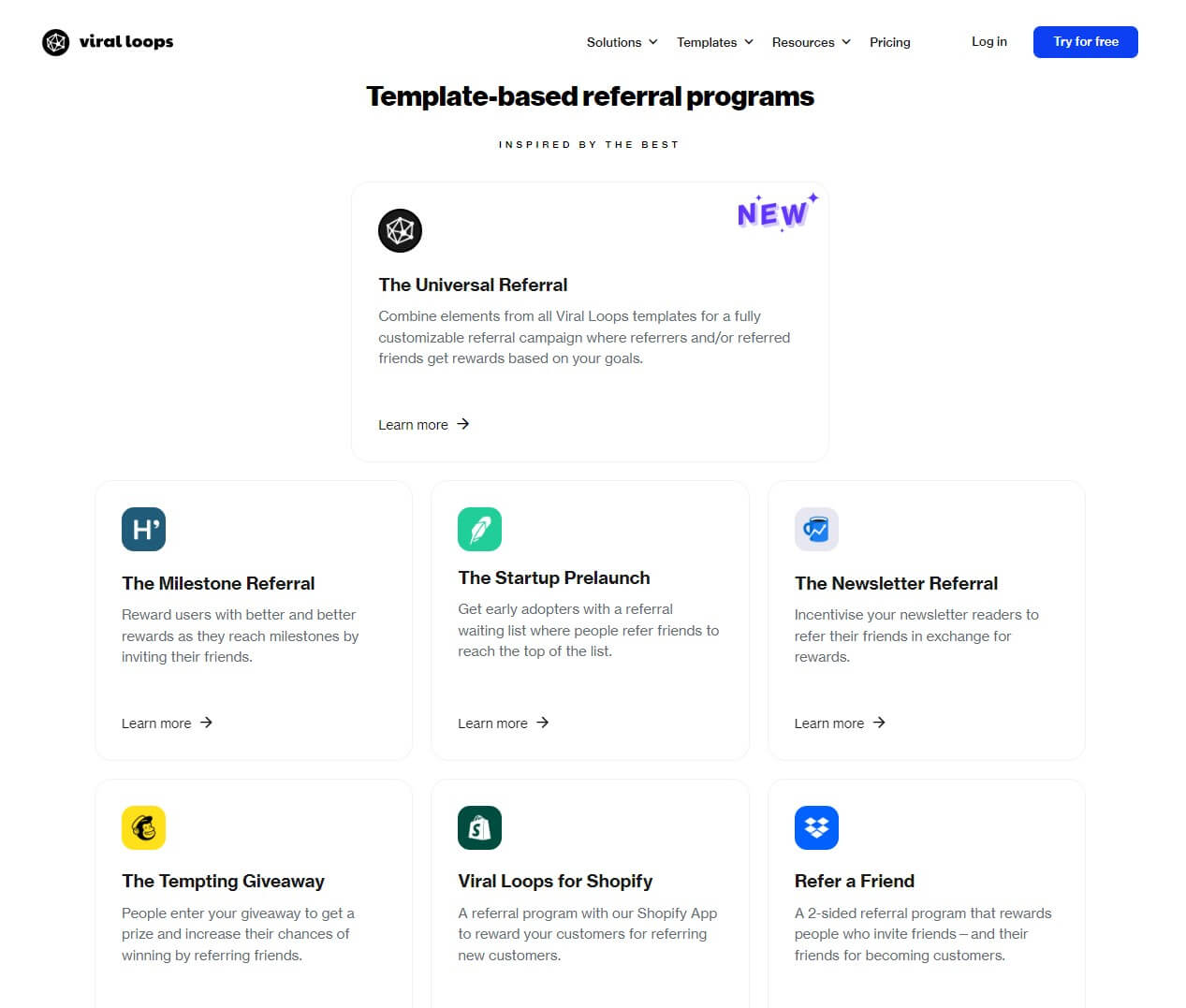
- E-commerce Businesses: This group thrives on tangible product sales and customer retention. Our Shopify referral template can help online stores encourage their current customers to refer friends by leveraging discounts or cashback rewards.
- Tech & Apps Companies: Companies in this segment focus on subscriptions and user engagement. Companies could use the Prelaunch referral template to give referrers early access to the tech product once they reach the top of the waiting list by referring friends.
- Creators & Media Companies: These businesses often rely on audience growth and engagement. The Newsletter referral template can be perfect for them. They can incentivize their newsletter readers for bringing in new subscribers.
- Events Promotions: With events being time-sensitive, this group can benefit from a referral tool that offers exclusive backstage access to events for both referrer and referee. This is where the Tempting referral template can work wonders.
- SaaS Companies: For Software as a Service companies, customer retention is key, alongside acquiring new users. A Milestone referral program can highlight tiered benefits, where the more friends a user refers, the more premium features they unlock.
Our marketing team focuses on the efficiency of Viral Loops in quickly growing user bases and retaining existing customers through engagement incentives.
Step 4: Test, Learn, and Improve
Experiment and Track
Try out different strategies and see what clicks. Use tools to measure how well each approach works—are people engaging, are referrals rolling in? Keep a close eye on these metrics.
Refine and Repeat
Take what you learn and tweak your strategies. The more you fine-tune, the better your referral programs will perform. It’s all about continuous improvement.
Divide and Conquer: Tailor Your Market Tactics for Precision Targeting
As we close the chapter on mastering the art of identifying and segmenting your target market, remember: one size fits all is out, and tailor-made is in! When you get to know your audience’s quirks and perks, your referral program will go from a gentle breeze to a full-on rocket launch!
So, grab your segmentation scissors and start snipping away at those one-size-fits-none tactics. Who knows? Your next referral success might just be one cleverly targeted recommendation away!
